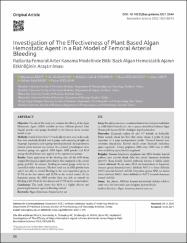Investigation of the effectiveness of plant based algan hemostatic agent in a rat model of femoral arterial bleeding

View/
Access
info:eu-repo/semantics/openAccessDate
2022Author
Ekici, HüsamettinKumandaş, Ali
Özbaykuş, Abdullah Canberk
Dizdaroğlu, Hazal
Midi, Ahmet
Balık, Mehmet Sabri
Yeşilada, Erdem
Metadata
Show full item recordCitation
Ekici, H., Kumandas, A., Ozbaykus, A.C., Dizdaroglu, H., Misi, A., Balik, M.S. & Yesilada, E. (2022). Investigation of The Effectiveness of Plant Based Algan Hemostatic Agent in a Rat Model of Femoral Arterial Bleeding. Bezmialem Science, 10(1), 88-95. http://doi.org/10.14235/bas.galenos.2021.5544Abstract
Objective: The aim of this study is to evaluate the efficacy of the Algan Hemostatic Agent (AHA) available in three different physical form (liquid, powder and sponge absorbed) in the femoral artery incision model in rats.
Methods: A total of sixty-four 5-7 weeks old rats were used in the study. Rats were randomly divided into 8 groups each consisting of eight rats (4 groups heparinized and 4 groups non-heparinized). An experimental femoral artery incision was created. As a control, physiological saline absorbed sponge was applied. AHA liquid, AHA powder and AHA sponge absorbed forms were applied to the experimental groups.
Results: Upon application to the bleeding sites, all the AHA forms stopped bleeding in a significantly shorter time compared to the control group (p<0.05). In contrast, bleeding in control group could not be controlled within 4 minutes. The best result was in AHA powder form and it was able to control bleeding in the non-heparinized group at 87.5% in the first minute and 12.5% in the second minute. In the heparinize group, the AHA powder form was able to control the bleeding at 62.5% in the first minute and 37.5% in the second minute.
Conclusion: This study shows that AHA is a highly effective and promising hemostatic agent in bleeding control.

















